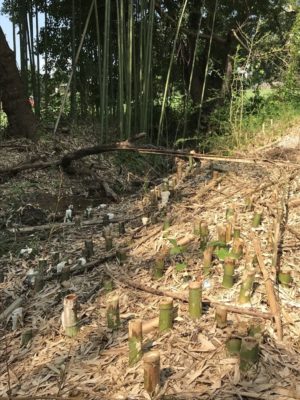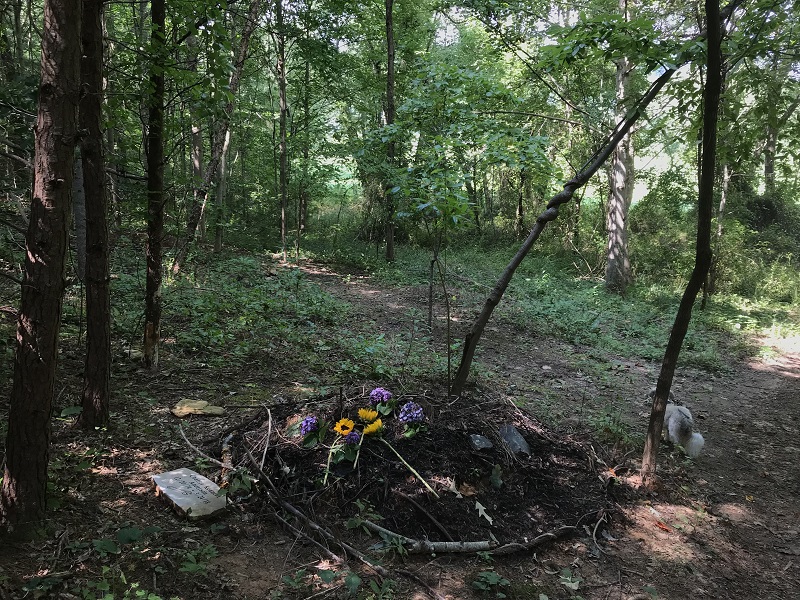Returning to the Earth
If you are interested in green burial at Carolina Memorial Sanctuary, please let them know that you heard about them through Conserving Carolina. The sanctuary donates a portion of the proceeds from site sales to Conserving Carolina. If they know that you learned about them through Conserving Carolina, this donation is tripled and you get a discount. Learn more.

Carolina Memorial Sanctuary creates a place for green burial
Caroline Yongue had taken on the task of creating a conservation burial ground in Mills River. But the land was an impenetrable mass of weeds—hundreds of young Bradford pear trees, poison ivy growing high and dense, kudzu and bittersweet choking trees. You couldn’t walk through it.
She says, “There was kind of a freak-out for me, like, ‘Holy crap, what am I going to do with this?’”
But Caroline has a way with fear. It was one reason why her Buddhist teacher asked her to start doing death care.
“She saw in me that I had a willingness to step past my fear,” Caroline says. “That when it arose, I saw it as an opportunity to go beyond. I didn’t let it stop me.”
Over 20 years ago, her teacher asked her to figure out how to take care of a dead body, without embalming, to be cared for by friends and family. “I thought it was an unusual question,” Caroline says, “but I trusted her that she knew my practice, so I said okay.”
At the time, Caroline says, “I had never seen death!”
She went through the process for the first time with an ailing kitten. “I talked to him about what was happening and I held him as he was dying.” Afterward, she laid out his tiny body, allowing time for the spirit to pass from the body.
When Ruby, the mother of a friend, was dying, Caroline asked if she would be willing to help her train and Ruby agreed. “I interviewed her about her death and dying, what she wanted, what were her spiritual practices, what did she believe was going to happen with her body after death. We provided all those things for Ruby as she was dying and at her death,” Caroline says.
But to go there, she had to step through fear. She says, “There was a voice in the back of my head going, ‘What are you doing? You don’t know what you’re doing! You can’t do this. You’re a fraud, blah blah blah blah.’ But I just kept doing it. I learned. And I continue to learn.”

Restoring the Land
Caroline began serving as a death doula and death midwife. She started the Center for End of Life Transitions, facilitating home funerals and teaching people how to prepare for death. And she was interested in starting a conservation burial ground.
The time felt right in 2007, when she was newly married. She found 30 acres in Black Mountain. But things didn’t go according to plan, as the economy tanked. Caroline went through a serious illness and a divorce. She let the idea go.
Then, in 2014, a friend reached out. Her church in Mills River—Unity Center of the Blue Ridge—owned some extra land and they were interested in starting a green burial ground. Caroline decided to sell her home in West Asheville and gave the money to her Buddhist group, which purchased the land to start Carolina Memorial Sanctuary.
That’s how she found herself in charge of 11 acres of vigorous weeds.
“One of the good things and the bad things about me is I can envision,” Caroline says. “I can manifest things just by thinking about it and envisioning it. So I just trusted the process. There were certainly times ‘When I was like what the bleep am I doing?’ Part of this is my Buddhist practice. I just go, ‘Well, you just do the next thing.”
One of her goals was to ensure lasting conservation of the land. But, when Kieran Roe and Tom Fanslow from Conserving Carolina—a local land trust—first came out, they told Caroline that the land didn’t have much going for it, ecologically. There was a creek that flows into the French Broad River and a wetland that had been partially filled in. So, it had potential, but it would take a lot of work to bring it back as a healthy natural habitat.

Caroline went for it. First, the sanctuary hired a contractor to clear out undesirable trees. For a year, Caroline and her small staff just watched what came back. The next step was to start removing invasives.
The land is a work-in-progress, with Caroline pointing out where an archway will go, a white oak, a composting toilet, graveled paths, a garage. In August, as she walked with her dog, Jasper, the meadow was full of Joe Pye Weed, with globes of purple blossoms swaying well above her head. Goldenrod, ironweed, and butterfly weed were blooming, with monarch and swallowtail butterflies flitting over the flowers.
Recently, Conserving Carolina helped the sanctuary secure grants for an ambitious restoration project—to reclaim the wetland, reshape eroding stream banks, and remove invasives, including kudzu and bamboo. Soon, the land trust and the sanctuary will finalize a conservation easement to ensure that the land will be protected forever. Carolina Memorial Sanctuary also donates a portion of the sale of burial sites to support Conserving Carolina.
Taking Death Back
In these natural surroundings, people give their loved ones back to the earth—both people and pets. And the meadow, woodland, wetland, and stream create a place where people want to come back and reflect.
The sanctuary offers sites to scatter ashes or bury a body, in harmony with nature. Bodies are buried without embalming fluid in a shroud or coffin that will break down underground. Graves are dug only three feet deep so that plants can benefit from the nutrients. Ashes are amended in order to keep the soil chemistry balanced.
Each rite of passage is different, Caroline says. They’ve had Christian, Jewish, Buddhist, and Wiccan ceremonies. “I have to get out of the way, because I don’t know what their experience needs to be,” she says. “You’ve always got to be stepping back, stepping out of me so that what is greater can show itself.”
People may help carry in their loved one’s body or cover it with earth, in some cases having helped to prepare the body. Caroline says, “The other option, that the body’s gone and you might be able to see it at a funeral home embalmed and it doesn’t look like your mother and you don’t want to touch it and you don’t want to emote and you’re in a hurry—it’s so unnatural. Now being able to do this, by the time people finish covering the grave, they’re laughing, they’re not crying anymore. They’re just so joyous, they’re chatting, they’re telling stories about the person.”
Through all of her death care work, she says, “I think the idea is helping people take death back into their own hands and not be afraid of it. It’s part of life. And there’s a great healing that happens.”
She tells a story of one man whose husband died suddenly. When he contacted Caroline, the body had already been taken away, but she let him know that they could bring it back to their home. Before the burial, she helped the man and his friends prepare the body. “I just facilitated the home funeral where I just directed his gay friends to bathe and dress this man. We just stood back and provided support and they did it. It was one of the most beautiful home funerals I’ve ever done because these men were taking care of this man. And the man whose husband died said that because he was able to still participate—even though he died suddenly—it was so transforming to him.”
Related: Conservation Burial Ground Protected

Article by Rose Jenkins Lane, communications and marketing director. Rose writes the monthly Stories of the Land series for the Hendersonville Times-News.